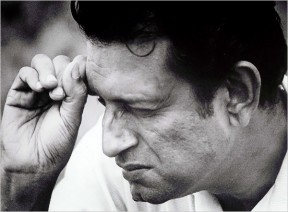Like all great endeavours, the timeless Pather Panchali by the legendary Satyajit Ray faced many obstacles on the way to immortality.Well, how this excellent story by Bibhutibhushan Bannerjee made its way onto the celluloid is an engrossing, fascinating tale in itself. Here goes….
As most of us know, Ray started off as an advertising professional. In June, 1943, he joined D.J. Keymer & Co. as a Junior Visualiser at a salary of Rs.65 plus a Dearness Allowance of Rs.15. He found a mentor in one D.K. Gupta, a manager with the agency. DK, (as most in the agency affectionately called Mr. Gupta) apart from his regular day job of advertising, was really interested in book production, which made him set up a publishing concern of his own, and he called it Signet Press
Now, Ray was an artist in his own right even back then, being an alumnus of Santiniketan, where he learned painting/sketching under the tutelage of icons like Binode Behari Mukherjee and Nandalal Bose. Given his flair for designing, DK soon roped him in to design the cover jackets to the books published by Signet Press. In 1944, DK resolved to bring out an abridged version of Bibhutibhushan Bannerjee’s acclaimed classic Pather Panchali, targeted towards young readers. It was termed Aam Atir Bhepu, roughly translated as ‘the mango seed bugle’. In Ray’s own words:
“I had not read the original novel. In fact, in my preoccupation with music and films, my reading was largely restricted to books on these two subjects and to light English fiction. To be quite frank, I was even unfamiliar with the bulk of Tagore’s writings. DK discovered this lacuna and castigated me. Then he gave me the original book of Pather Panchali to read, because, he warned me, ‘you will have to illustrate the abridged version!”
Ray was filled with admiration for the book at his very first reading. He believed it to be ‘a masterpiece and a sort of encyclopedia of life in rural Bengal.’ He went on to read the abridged version, which covered about a third of the original novel. DK, an ex-editor of a Bengali film magazine for some years prior to his advertising career, commented that this abridged book would make a very good film. Ray paid little attention to the idea and went on with the illustrations, but that was when the seeds for The Song of The Little Road were sown.
One of the most significant events in the would-be film maestro’s life happened in 1949, when he met up Jean Renoir. Renoir was in Calcutta to look for actors and locations for his film The River . A classified ad in The Statesman saying that Renoir had put up in the Great Eastern Hotel and would be interviewing for actors in his new film attracted his attention. Ray rushed to the hotel, met Renoir and introduced himself as one of his ardent admirers (Ray especially liked Renoir’s The Southerner). They got talking and Renoir was astonished that an Indian was so conversant about his works. One thing led to another and Renoir asked Ray if he was interested in making films and Ray ‘found himself’ replying in the affirmative. Ray says:
“Have you found a subject?’-he asked. I gave him a brief outline of Pather Panchali, the idea of making a film of which had in the meantime taken hold of me. As I drove through the countryside with Renoir, it had been occupying my mind – not the entire novel, but the abridged version, which seemed to correspond more to a film script. Renoir encouraged me. I had taken him to see a few Bengali films and he had requested me not to borrow from American films, “You can turn aside from the Hollywood world.”
Renoir came back to Calcutta in 1950 to shoot The River and Ray’s friend Bansi Chandragupta was roped in as Art Director for the same, while another friend, Harisadhan Das Gupta was taken in as Assistant Director. Ray got to read the script this time. Meanwhile, he had been promoted as Art Director in D.J. Keymer, and the company sent him to London and Europe for six months. Ray was beside himself with delight. Now he could see films that had not come to India. Ray saw 99 films in four- and- a- half months, (a record by the standards of the craziest cine-fanatic even today) and a few more in Paris !Renoir went back to Hollywood, leaving behind Ray, now quite resolved to make a film of his own. Ray started writing scripts ‘just for the fun of it’. He would take a short story/novel that had been announced as being under production, write a script on it and then compare it with the final treatment when the film came out. At this point he decided to make a film on Tagore’s Home and the World, which fell through pretty soon due to some differences of opinion, and thank God for it, because years later in 1984, he would make The Home and the World, which, as acknowledged by him, was a much better and matured work.
On the way back home, on board the Chusan, Ray completed his treatment of Pather Panchali
……to be concluded. Meanwhile, I’ll leave you with this: Ray Archives
P.S. I have drawn heavily from My Years with Apu: A Memoir by The Master himself, and Portrait of A Director: Satyajit Ray by Marie Seton
Amborish Roychoudhury is a film enthusiast and a film buff who lives within this outer shell of a finance professional. He is extremely passionate about films, comics, old Hindi film music, detective fiction, technology and the like – He worships many deities but works for the devil! Another Blog that he write occasionally is http://amborish.posterous.com/or just go to amborish.com






